Roadrunner Transportation Bundle
Can Roadrunner Transportation Company Outrun Its Past and Deliver Future Growth?
Roadrunner Transportation Company, a name synonymous with the evolution of the Roadrunner Transportation SWOT Analysis, has navigated a complex journey within the North American transportation industry. From its humble beginnings in 1984, the company has transformed through mergers, acquisitions, and strategic shifts, ultimately aiming to solidify its position in the competitive freight and shipping landscape. This analysis delves into Roadrunner's growth strategy, examining its past, present, and future prospects.
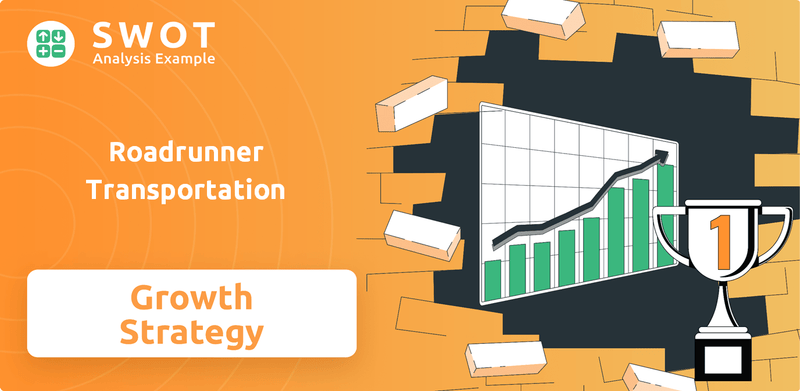
Roadrunner's story is one of adaptation and resilience, making it a compelling case study for understanding the dynamics of the logistics sector. The company's strategic refocus on its core LTL expertise, coupled with investments in technology and expansion, suggests a renewed commitment to sustainable revenue growth. Understanding the challenges and opportunities facing Roadrunner Transportation Company provides valuable insights for investors and industry professionals alike, especially when considering the company's market share and financial performance.
How Is Roadrunner Transportation Expanding Its Reach?
The Roadrunner Transportation Company is actively pursuing a robust Growth Strategy to strengthen its position in the Transportation Industry. This involves significant expansion initiatives aimed at broadening its market reach and enhancing its service offerings. The company's focus on premium LTL (Less-Than-Truckload) long-haul carrier service with minimal freight re-handling is a key differentiator.
A core element of this strategy is the continuous expansion of its direct metro-to-metro network across North America. This approach allows for faster and more reliable deliveries, which is a significant advantage in the competitive Logistics landscape. By strategically adding new lanes and expanding its operational footprint, Roadrunner aims to meet the growing demands of shippers.
The company's expansion efforts are also supported by strategic acquisitions and infrastructure investments. These moves demonstrate Roadrunner's commitment to long-term growth and its ability to capitalize on market opportunities. For a deeper understanding of their business model, consider exploring Revenue Streams & Business Model of Roadrunner Transportation.
In January 2024, Roadrunner launched its most extensive new market opening in five years, introducing LTL service into Portland, Oregon, and extending services to Toronto and Montreal, Canada, via Detroit. This strategic move enhanced cross-border service capabilities. These expansions are designed to provide shippers with improved access to key metropolitan areas and strengthen the company's cross-border capabilities.
In March 2025, Roadrunner added 278 new lanes to its Smart Network, with a third being '1,000+ Mile Power Lanes'. These additions strengthened outbound service in major metro markets. Further expansion included 18 new inbound LTL lanes into Richmond, Virginia, in May 2025, connecting it to major cities.
Roadrunner's acquisition of a former YRC Freight terminal in Atlanta in 2024, secured during the Yellow Corp. bankruptcy auction, highlights its strategic growth in key markets. This acquisition expanded its reach to over 40 metro markets. This strategic move underscores the company's commitment to strengthening its operational capabilities and market presence.
Roadrunner aims to enhance its presence in border cities, actively seeking a more permanent operation in Laredo, Texas. The company's management has indicated that future growth could also involve mergers and acquisitions. These plans reflect a proactive approach to expanding its footprint and service offerings.
Roadrunner's expansion strategy focuses on several key areas to enhance its service offerings and market reach. This includes strategic market openings, network enhancements, and strategic acquisitions. These initiatives are designed to improve service quality and expand its operational capabilities.
- Expanding its direct metro-to-metro network.
- Adding new lanes, including '1,000+ Mile Power Lanes'.
- Acquiring strategic assets, such as the Atlanta terminal.
- Enhancing presence in border cities like Laredo.
Roadrunner Transportation SWOT Analysis
- Complete SWOT Breakdown
- Fully Customizable
- Editable in Excel & Word
- Professional Formatting
- Investor-Ready Format
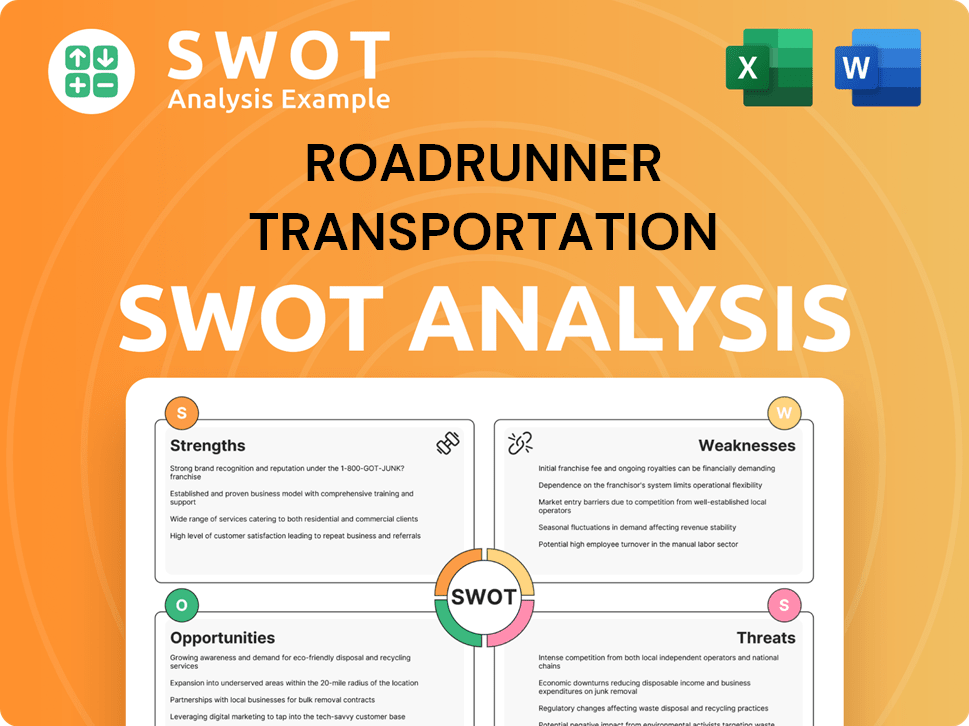
How Does Roadrunner Transportation Invest in Innovation?
The focus on innovation and technology is central to the Roadrunner Transportation Company's growth strategy within the dynamic transportation industry. This commitment allows the company to enhance operational efficiency, improve customer experiences, and maintain a competitive edge. By strategically investing in cutting-edge technologies, the company aims to optimize its services and adapt to the evolving demands of the logistics and freight sectors.
The 'Smart Network' is a key component of their strategy, leveraging AI and machine learning to provide real-time tracking and visibility. This technological integration enables direct routing, reducing the need for rehandles and freight handovers. This approach minimizes the risk of loss or damage, contributing to faster transit times and improving overall service reliability.
The company's digital transformation strategy is evident in its use of machine-learning algorithms to optimize network operations. This focus on data analytics and technology has been a key factor in its operational improvements and customer service, aiming to make the company a more competitive and resilient player in the transportation industry.
Roadrunner Transportation Company utilizes AI and machine learning to enhance its operational efficiency and improve customer service. This integration is a cornerstone of their technology adoption strategy, ensuring real-time tracking and visibility.
The company's focus on direct routing minimizes rehandling, reducing the risk of damage and speeding up transit times. Continuous routing optimization, powered by machine learning, results in an efficient Smart Network connecting major U.S. metros.
Data analytics and technology are key factors in Roadrunner's operational improvements and customer service enhancements. They aim to become a more competitive and resilient player in the transportation industry through these initiatives.
Roadrunner's commitment to innovation has been recognized through industry accolades, such as the Breakthrough Carrier of the Year Award from GLT Logistics in 2023. This recognition highlights their dedication to fostering innovation and improvement within the freight and logistics sectors.
The Smart Network focuses on long-haul lanes, connecting major U.S. metros, with an emphasis on direct, long-haul shipping. This approach ensures faster and more reliable deliveries, distinguishing their service offerings in the LTL sector.
Roadrunner Transportation Company continuously invests in innovative technologies and automation to improve efficiency and customer experience. This investment is a cornerstone of its growth strategy.
Roadrunner's innovation strategy includes several key initiatives aimed at enhancing its market position and service offerings within the transportation industry.
- AI-Driven Optimization: Implementation of AI and machine learning for route optimization, predictive maintenance, and enhanced operational efficiency.
- Real-Time Tracking: Providing customers with real-time visibility into their shipments, improving transparency and customer satisfaction.
- Data Analytics: Utilizing data analytics to identify trends, improve decision-making, and optimize network performance.
- Automation: Investing in automation technologies to streamline processes, reduce labor costs, and improve the speed of operations.
- Digital Platforms: Developing user-friendly digital platforms for booking, tracking, and managing shipments, enhancing customer experience.
Roadrunner Transportation PESTLE Analysis
- Covers All 6 PESTLE Categories
- No Research Needed – Save Hours of Work
- Built by Experts, Trusted by Consultants
- Instant Download, Ready to Use
- 100% Editable, Fully Customizable
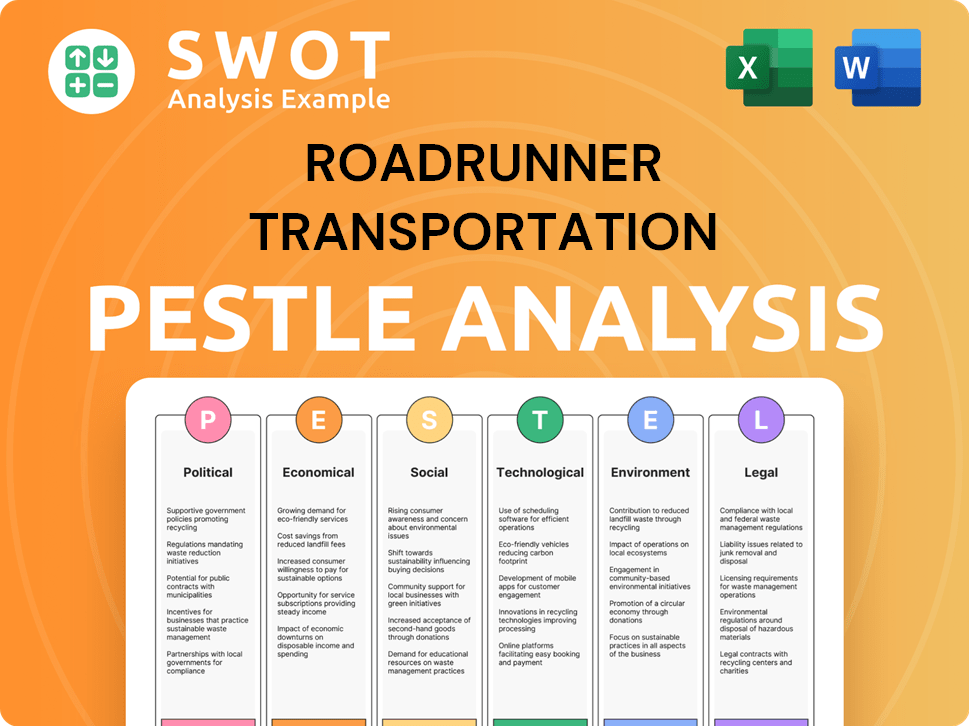
What Is Roadrunner Transportation’s Growth Forecast?
The financial outlook for Roadrunner Transportation Company is significantly influenced by its recent restructuring and strategic focus on its core Less-Than-Truckload (LTL) business within the transportation industry. The acquisition of a majority ownership interest by Prospero Staff Capital in November 2024, with participation from Roadrunner Freight CEO Chris Jamroz and investor Ted Kellner, marks a pivotal shift. This transaction, supported by a minority stake retained by Elliott Investment Management, is designed to inject fresh capital, fueling both organic growth and potential acquisitions. This strategic move is critical for Roadrunner's growth strategy.
While specific financial targets for 2024-2025 are not explicitly detailed in recent reports, the company's leadership expresses optimism. CEO Chris Jamroz's statement in December 2024, suggesting that Roadrunner would likely experience one of its best years in the last decade, reflects confidence in the operational improvements and network enhancements implemented. This positive sentiment is a key indicator of the company's financial health and future prospects within the logistics and freight sectors.
Roadrunner's financial strategy includes a General Rate Increase (GRI) of 6.9%, effective January 15, 2025, applied to rates under the RDFS 501 tariff. This marks the first across-the-board rate adjustment since 2021, addressing rising operational costs and supporting improvements to its service offerings. The company's stock (RRTS) was trading at $3.00 as of May 30, 2025, with a market capitalization of $115 million. For more insights, you can read the Brief History of Roadrunner Transportation.
The stock (RRTS) traded at $3.00 as of May 30, 2025, with a market capitalization of $115 million. Forecasts suggest an average price of $1.861 in 2025, with a high of $2.74 and a low of $0.9819. Long-term projections anticipate significant growth.
A 6.9% GRI was implemented on January 15, 2025, to address rising costs and enhance service offerings. The company is pursuing an asset-light strategy, focusing on independent owner-operators for scalability and efficiency.
Average price of $10.94 by 2030, $22.88 by 2040, and $42.31 by 2050. However, as of May 27, 2025, the stock had negative signals, leading to a negative evaluation from some analysts.
Roadrunner's current fleet of vehicles is approximately 1,000. The company emphasizes minimizing company-owned assets. This approach aims for scalability and efficiency, as the company is not a 'huge fan of owning rolling stock and things that depreciate'.
Roadrunner Transportation Business Model Canvas
- Complete 9-Block Business Model Canvas
- Effortlessly Communicate Your Business Strategy
- Investor-Ready BMC Format
- 100% Editable and Customizable
- Clear and Structured Layout
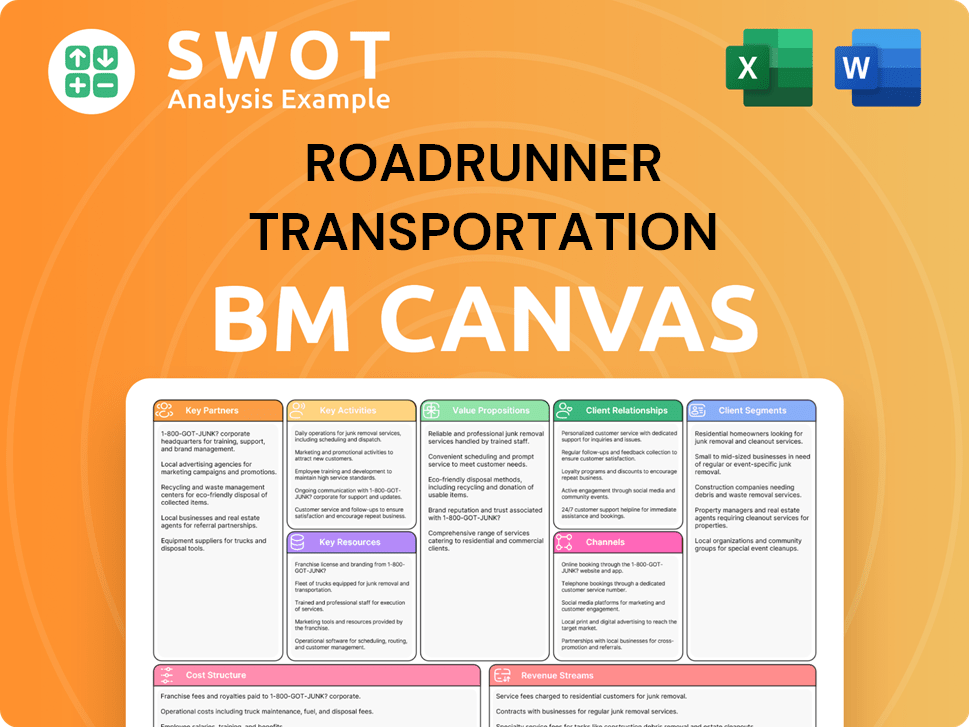
What Risks Could Slow Roadrunner Transportation’s Growth?
The Roadrunner Transportation Company's ambitious growth strategy faces several potential risks inherent in the dynamic transportation industry. These challenges range from intense market competition and fluctuating economic conditions to the need for continuous technological adaptation. Understanding these obstacles is crucial for assessing the company's future prospects and investment potential.
Market dynamics present significant hurdles, including demand fluctuations, overcapacity, and economic uncertainty, which can directly impact profitability. Regulatory changes and evolving consumer behaviors add further layers of complexity. Addressing these risks requires proactive strategies and robust operational frameworks to ensure sustainable growth and competitive advantage.
Internal resource constraints, especially regarding drivers and equipment, can also affect growth. The past struggles highlight the importance of robust internal controls and risk management frameworks. Management's focus on operational overhaul and network improvements indicates a proactive approach to building resilience. For more insights, consider exploring the Competitors Landscape of Roadrunner Transportation.
The Roadrunner Transportation Company operates within a highly competitive market, including numerous established players in the LTL and logistics sectors. Intense competition can squeeze profit margins and necessitate continuous efforts to differentiate service offerings. This competitive landscape impacts the Roadrunner Transportation Company market share and overall financial performance.
Economic downturns and fluctuations in freight demand can significantly affect Roadrunner Transportation Company's revenue and profitability. The ongoing freight recession, although showing signs of receding, has compelled carriers to focus on cost control. Economic instability poses a continuous challenge to the Roadrunner Transportation Company future outlook.
Changes in regulations, such as those related to emissions, safety, and driver hours, can increase operational costs and compliance requirements. The NMFTA's planned rollout of density-based classification necessitates adjustments for carriers. These regulatory shifts are among the key Roadrunner Transportation Company challenges.
Fluctuations in fuel prices directly impact operational costs, affecting profitability. The company's reliance on fuel means that any significant price increases can erode profit margins. Managing fuel costs is critical for maintaining Roadrunner Transportation Company's revenue growth.
The rapid pace of technological advancements, including AI and IoT, requires continuous investment and adaptation. Technological disruptions can impact efficiency and service levels. Successful Roadrunner Transportation Company technology adoption is crucial for staying competitive.
The availability and retention of qualified drivers and equipment are essential for maintaining operational efficiency. Challenges in this area can hinder the company's ability to meet demand and sustain growth. Addressing these constraints is vital for the Roadrunner Transportation Company expansion plans.
Roadrunner Transportation Company is pursuing mergers and acquisitions as part of its growth strategy, which introduces integration risks. The company's asset-light strategy, while efficient, relies on independent owner-operators and team drivers, creating dependencies. These strategic moves need careful planning and execution to mitigate potential pitfalls and ensure long-term success.
The company's past accounting scandal highlights the importance of robust internal controls and risk management. Supply chain vulnerabilities, although not explicitly detailed in recent reports, are a general risk. Effective management of these operational aspects is critical for maintaining customer satisfaction and achieving sustainable Roadrunner Transportation Company revenue growth.
Roadrunner Transportation Porter's Five Forces Analysis
- Covers All 5 Competitive Forces in Detail
- Structured for Consultants, Students, and Founders
- 100% Editable in Microsoft Word & Excel
- Instant Digital Download – Use Immediately
- Compatible with Mac & PC – Fully Unlocked
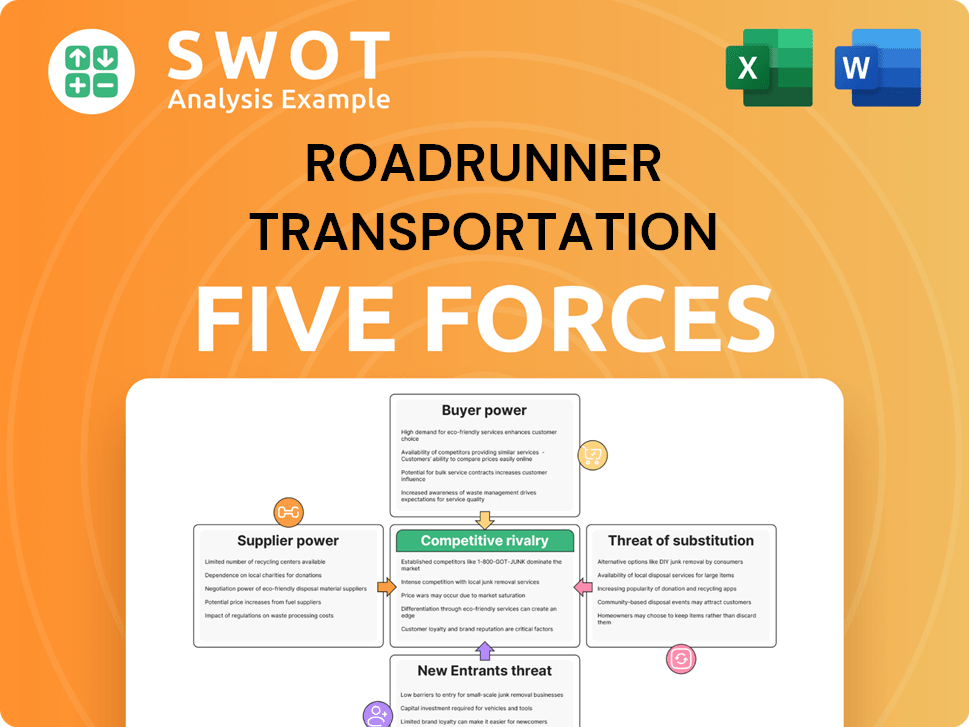
Related Blogs
- What are Mission Vision & Core Values of Roadrunner Transportation Company?
- What is Competitive Landscape of Roadrunner Transportation Company?
- How Does Roadrunner Transportation Company Work?
- What is Sales and Marketing Strategy of Roadrunner Transportation Company?
- What is Brief History of Roadrunner Transportation Company?
- Who Owns Roadrunner Transportation Company?
- What is Customer Demographics and Target Market of Roadrunner Transportation Company?
Disclaimer
All information, articles, and product details provided on this website are for general informational and educational purposes only. We do not claim any ownership over, nor do we intend to infringe upon, any trademarks, copyrights, logos, brand names, or other intellectual property mentioned or depicted on this site. Such intellectual property remains the property of its respective owners, and any references here are made solely for identification or informational purposes, without implying any affiliation, endorsement, or partnership.
We make no representations or warranties, express or implied, regarding the accuracy, completeness, or suitability of any content or products presented. Nothing on this website should be construed as legal, tax, investment, financial, medical, or other professional advice. In addition, no part of this site—including articles or product references—constitutes a solicitation, recommendation, endorsement, advertisement, or offer to buy or sell any securities, franchises, or other financial instruments, particularly in jurisdictions where such activity would be unlawful.
All content is of a general nature and may not address the specific circumstances of any individual or entity. It is not a substitute for professional advice or services. Any actions you take based on the information provided here are strictly at your own risk. You accept full responsibility for any decisions or outcomes arising from your use of this website and agree to release us from any liability in connection with your use of, or reliance upon, the content or products found herein.